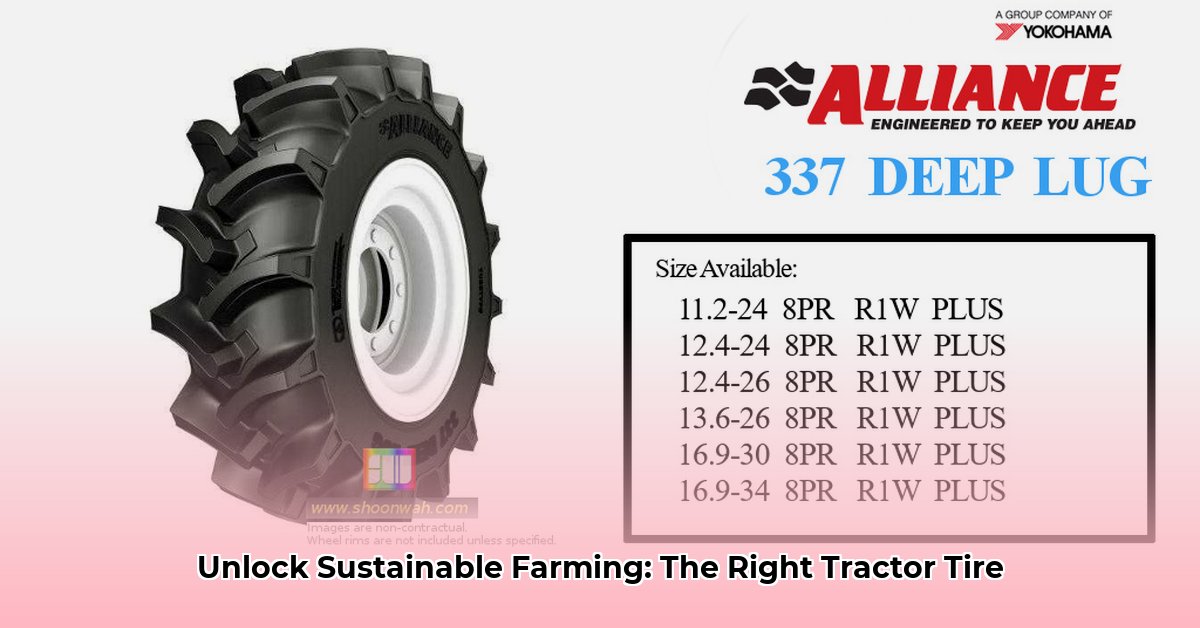
Choosing the right tractor tires is crucial for efficient and sustainable farming. This guide focuses on selecting the optimal 12.4-26 tire, considering factors that impact fuel efficiency, soil health, and environmental sustainability. We'll break down the technical aspects, offer practical advice, and provide a clear path to making an informed decision. For more tire options, check out this helpful resource: tire selection guide.
Decoding the 12.4-26 Tire Specification
The "12.4-26" designation on a tire provides essential size information. "12.4" represents the tire's section width in inches (the distance from sidewall to sidewall), while "26" refers to the wheel diameter in inches. However, simply understanding these dimensions is insufficient for making an informed purchasing decision. Several critical factors must be considered:
Key Factors Beyond Basic Dimensions
Load Capacity: This specifies the maximum weight a tire can safely carry. Overloading can lead to tire failure and damage to your tractor. Always check your tractor's specifications to ensure the chosen tire can handle its load.
Ply Rating: This indicates the tire's strength and durability. A higher ply rating generally means more robust construction, offering enhanced resilience and a longer lifespan. Higher ply ratings may increase rolling resistance, though, resulting in slightly reduced fuel efficiency.
Rim Diameter: The rim diameter must precisely match the inside diameter of your tractor's wheel. An improper fit risks damage to both tire and wheel.
Radial vs. Bias-Ply Tires: A Comparative Analysis
Two main tire constructions exist: radial and bias-ply. Each offers distinct advantages and disadvantages affecting several key areas:
| Feature | Radial | Bias-Ply |
|---|---|---|
| Soil Compaction | Significantly less | More |
| Fuel Efficiency | Higher | Lower |
| Tire Lifespan | Generally longer | Shorter |
| Initial Cost | Higher | Lower |
| Ride Comfort | Smoother | Rougher |
Isn't the higher initial cost of radial tires offset by their longer lifespan and reduced fuel consumption? A thorough cost-benefit analysis, considering the total cost of ownership over several years, frequently reveals significant long-term savings with radial tires.
Tire Selection Based on Soil Type
Optimal tire selection depends heavily on the type of soil you work with. Heavy clay soils generally benefit from wider tires to distribute weight more effectively and minimize compaction. This reduces soil damage and improves crop yields. Lighter, sandy loam soils, on the other hand, may require tires with different tread patterns optimized for traction on loose surfaces.
Isn't understanding your soil type crucial for maximizing the return on your tire investment? Choosing the right tire can translate to better yields and a healthier soil ecosystem.
Sustainable Considerations: Environmental Impact
Environmental responsibility is paramount in modern agriculture. Sustainable tire choices encompass several key components:
Manufacturing: Consider the materials used and the energy involved in production. Look for information about sustainable manufacturing practices employed by tire manufacturers.
Operational Efficiency: Tires with superior fuel efficiency directly minimize greenhouse gas emissions. Lower fuel consumption, in turn, reduces operating costs and environmental impact. Reduction in soil compaction also aids the long term health of the soil.
- End-of-Life Management: Investigate readily available tire recycling options within your area. Promote responsible disposal and recycling of used tires to minimize environmental harm.
Long-Term Cost Analysis: Beyond the Initial Price
The initial purchase price is just one component of the total cost. Factors like fuel efficiency, tire lifespan, and soil compaction impact long-term expenses. While initial costs may be higher for radial tires, long-term savings often make them a more cost-effective option. Reduced fuel consumption, extended lifespan, and diminished soil damage contribute significantly to these savings. Professor David Miller, Agricultural Engineering, Purdue University, notes: "Farmers should consider the total cost of ownership, including fuel, maintenance, and replacement, when selecting tires."
Actionable Steps for Choosing Your 12.4-26 Tire
Follow this step-by-step guide to make an informed decision:
- Assess Your Needs: Evaluate your soil type, typical loads, and tractor weight.
- Review Specifications: Analyze tire load capacity and ply rating to ensure they meet your requirements.
- Compare Tire Types: Weigh the advantages and disadvantages of radial and bias-ply tires, considering their impact on fuel efficiency, soil compaction, and lifespan.
- Factor in Soil Type: Select a tire with a tread pattern suitable for your specific soil conditions.
- Perform a Total Cost Analysis: Calculate the long-term cost, factoring in initial cost, fuel consumption, lifespan, and potential soil damage repair costs.
- Prioritize Sustainability: Consider the entire lifecycle of the tires, from manufacture to disposal. Choose tires made with sustainable materials and explore recycling options.
By diligently considering these points, you can select a 12.4-26 tractor tire that optimizes performance, minimizes costs, and promotes environmentally responsible farming practices.